3.4: Other Base Systems
- Last updated
- Save as PDF
- Page ID
- 82991
You will need: *Base Two Blocks, Base Three Blocks, Base Four Blocks, Unit Blocks (Material Cards 4 - 7), Calculator
IMPORTANT OBSERVATION
The actual blocks are 3-dimensional. The units, longs and flats from the material cards are only shown in 2-dimensions, so they wouldn't be too cumbersome to make. You have to imagine they are really made of cubes. The units are like dice. In base three, a long is 3 units together, so the dimensions are really 3 by 1 by 1 and a flat is made up of 3 longs, so the dimensions are really 3 by 3 by 1.
You can check out the base blocks from your instructor. Just send her an email requesting to borrow them.
Below is an amateur drawing of what a unit, long, flat and block really look like in Base Three.
|
Base Three unit 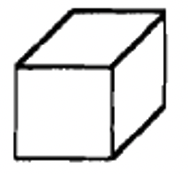 |
Base Three unit 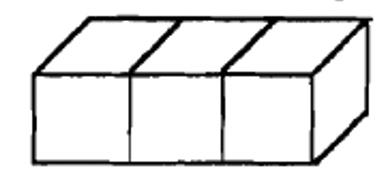 |
|
Base Three unit 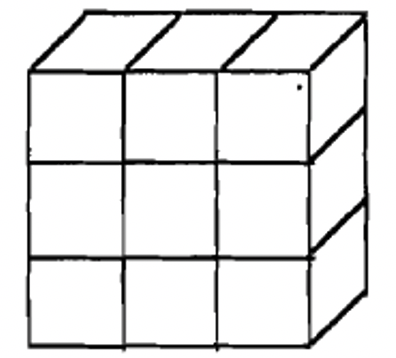 |
Base Three unit 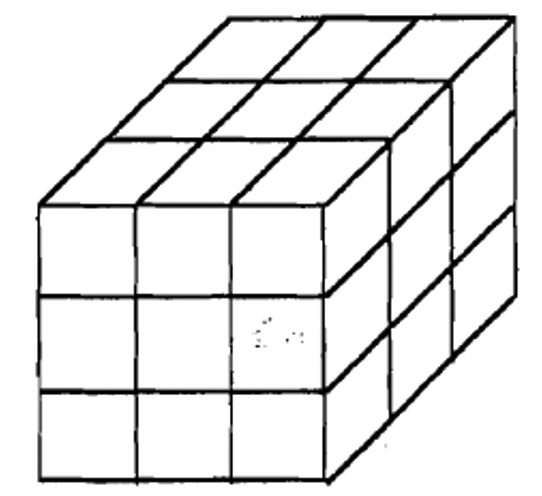 |
Since we only live in a three dimensional world, once we get past a block, we can't really draw in the 4th dimension or higher. Well, at least I can't. In Base Three, it takes three units to make a long, it takes three longs to make a flat and it takes three flats to make a block. In Base Three, the next level after a block is made by putting three blocks together and we call that a long block. Three long blocks put together is called a flat block, and three flat blocks put together is called a block block.
In Base Three, a unit is made up of 1 cube, a long is made up of 3 cubes, a flat is made up of 9 cubes, a block is made up of 27 cubes, a long block is made up of 81 cubes, a flat block is made up of 243 cubes, and a block block is made up of 729 cubes.
Base Two blocks are different. In Base Two, it takes two units to make a long, it takes two longs to make a flat and it takes two flats to make a block. In Base Two, the next level after a block is made by putting two blocks together and we call that a long block. Two long blocks put together is called a flat block, and two flat blocks put together is called a block block. Try to imagine what a unit, long, flat and block look like in Base Two before turning the page.
Below is an amateur drawing of a unit, long, flat and block in Base Two.
|
Base Two unit 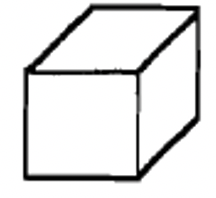 |
Base Two long 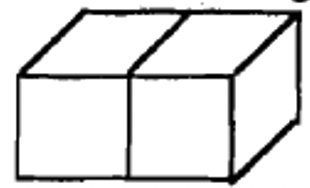 |
Base Two flat 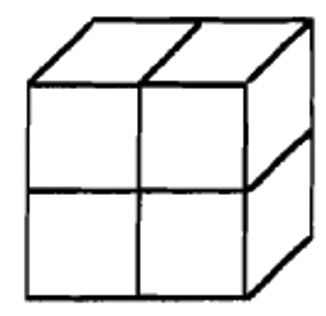 |
Base Two block 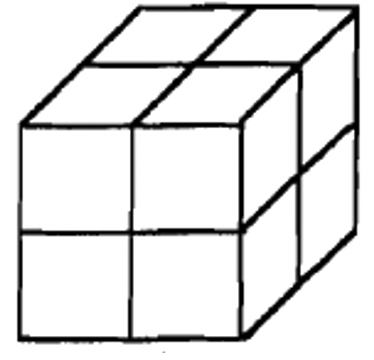 |
In base two, a unit is made up of 1 cube, a long is made up of 2 cubes, a flat is made up of 4 cubes, a block is made up of 8 cubes, a long block is made up of 16 cubes, a flat block is made up of 32 cubes, and a block block is made up of 64 cubes.
Exercise 1
Draw a picture of a Base Four unit, long, flat and block.
Exercise 2
Fill in the blanks.
a. In Base Four, it takes ____ units to make a long, it takes ____ longs to make a flat, it takes ____ flats to make a block, it takes ____ blocks to make a long block, it takes ____ long blocks to make a flat block, and it takes ____ flat blocks to make a block block.
b. In Base Four, a unit is made up of 1 cube, a long is made up of ______ cubes, a flat is made up of ______ cubes, a block is made up of ______ cubes, and a long block is made up of ______ cubes.
c. In Base Five, it takes ______ flats to make a block.
d. In Base Six, a flat is made up of ______ cubes.
Now that you have expertise in converting from other bases to Base Ten, we'll focus on converting from Base Ten to other bases. There is more than one way to accomplish this task. You will learn how to do it using two different approaches and then you can choose to use whichever method works best for you when working on the exercises. It is optimal if you understand and can convert using either method because as a teacher, one student may understand one explanation perfectly whereas another student might understand it better if it were explained quite differently.
Get out the blocks and work through these problems USING THE BLOCKS!
Before using either method, I want you to return to the process of exchanging like you did at the beginning of this exercise set. Instead of using the Base Two Models, this time we will use sets of Base Blocks in Base Two, Base Three and Base Four. You may have wood or plastic 3-dimensional sets in your classroom or you can make your own models using Material Cards 9-11. Remember that the material cards for the units, longs and flats are only two-dimensional. Keep the sets separate from each other. The units are the same for any set of Base Blocks so you only need a total of one set of units.
These next three exercises should be a piece of cake for you!
Exercise 3
Take out your set of Base Two Blocks. These consist of at least units, longs, flats, blocks, long blocks and flat blocks. How many units are in a long? _____ How many longs are in a flat? _____ How many flats are in a block? _____ How many blocks are in a long-block? _____ How many long-blocks are in a flat-block? _____
Exercise 4
Take out your set of Base Three Blocks. These consist of at least units, longs, flats and blocks. How many units are in a long? _____ How many longs are in a flat? _____ How many flats are in a block? _____
Exercise 5
Take out your set of Base Four Blocks. These consist of at least units, longs, flats and blocks. How many units are in a long? _____ How many longs are in a flat? _____ How many flats are in a block? _____
Place Value Chart for Base Blocks
| FB | LB | B | F | L | U |
Above is a place value chart for all bases when using Base blocks. U represents units, L represents longs, F represents flats, B represents blocks, LB represents long-blocks and FB represents flat-blocks. In general, there can be more than six place values, but six is sufficient to complete the exercises in this set. If you are using the Material Cards for Base Blocks, the Base Two blocks have all six types of blocks whereas the Base Three and Four blocks only have units, longs, flats and blocks.
Exercise 6
Imagine Maria had a baby and it was time for her six week check-up. It had been exactly six weeks since she had become a mother. You will be representing the number of days Maria has been a mother in Base Two, Base Three and Base Four using the Base Blocks.
a. To represent the number of days Maria has been a mom in Base Two, do the following using Base Two Blocks:
| i. Using the units, count out how many days Maria has been a mom. You have _____ units. |
| ii. Trade in the units for as many longs as possible. You now have _____ long(s) and _____ unit(s). |
| iii. Trade in the longs for as many flats as possible. You now have _____ flat(s), _____long(s) and _____ unit(s). |
| iv. Trade in the flats for as many blocks as possible. You now have _____ block(s), _____ flat(s), _____ long(s) and _____ unit(s). |
| v. Trade in the blocks for as many long-blocks as possible. You now have _____ long-block(s), _____ block(s), _____ flat(s), _____ long(s) and _____ unit(s). |
| vi. Trade in the long-blocks for as many flat-blocks as you can. You now have _____ flat-block(s), _____ long-block(s), _____ block(s), _____ flat(s), _____ long(s) and _____ unit(s). |
| vii. Record the results from part vi. in the first row of the chart in part d below. |
For parts b and c, make a series of exchanges like you did in part a, but use Base Three Blocks for part b and Base Four Blocks for part c. In other words, start with the same amount of units you had in part a.i. and begin by exchanging as many units for longs as possible. Then, trade as many longs for flats as possible, then flats for blocks, etc., until all possible exchanges have been made. You don't need to write down each individual step like you did for part a above just use the blocks and record the final results in part d.
b. Start with the same number of units you had in part a.i and make all possible exchanges using Base Three Blocks. When all trades have been made, record the results in the second row of the chart (Base Three) in part d below.
c. Start with the same number of units you had in part a.i and make all possible exchanges using Base Four Blocks. When all trades have been made, record the results in the third row of the chart (Base Four) in part d below.
d.
| FB | LB | B | F | L | U | Base | |
|---|---|---|---|---|---|---|---|
| results from part a: | Two | ||||||
| results from part b: | Three | ||||||
| results from part c: | Four |
Exercise 4 illustrates a way to change a numeral in Base Ten to one in a different base. For that exercise, you converted the Base Ten numeral 42 (six weeks of seven days each) to Base Two (\(101010_{\text{two}}\)), Base Three (\(1120_{\text{three}}\)) and Base Four (\(222_{\text{four}}\)). If you didn't get these answers, you should rework the problem using the physical models, and be careful about making accurate exchanges. Ask for help if you still have problems.
Exercise 7
Use the Base Blocks to convert the number of weeks in a year to a numeral in each of the bases given. You should first start out with the units and count out as many units as there are weeks in a year. Then, trade in units for as many longs as possible, next trade in longs for as many flats as possible and so on. Do this process for each base. Explain in words and/or show in a chart each step you took and what blocks you had at each step. State the exact number of each kind of block(s) you had when there were no more exchanges to be made. Finally, write the answer in the base requested on the space provided. Check your work by converting back to Base Ten. Use the physical models (get out the blocks) to do these problems!
a. Base Two ____
b. Base Three ____
c. Base Four ____
If we only needed to convert relatively small numbers and we always had Base Blocks available in any base we needed to convert to, we could continue to convert to various bases by using the blocks and doing exchanges. But this is not always the case. Consider if you were asked to convert 999 to Base Four. This would be pretty time-consuming and tedious. So, now we will explore ways to convert without using manipulatives.
Let's back up a step by considering how, by using manipulatives, we obtained the answer to exercise 2 of Exercise Set 3. Basically, we converted the Base Ten numeral 27 to a Base Two numeral using cups (units), pints (longs), quarts (flats), half-gallons (blocks) and gallons (long-blocks).
How did we do it?
1. Start by listing how many cups you start out with. See below.
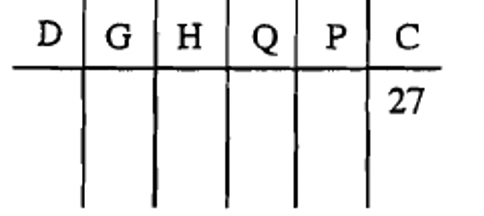
2. Next, to consolidate the cups into pints, we divide the number of cups (27 in Base Ten) by 2 (because we are converting to base Two) to get 13 pints (the quotient) with 1 cup left over (the remainder) when you divide 27 by 2, 13 is the quotient and 1 is the remainder. So, we now have 13 pints and 1 cup. Cross off 27 cups and show new quotient and remainder. Keep track in a chart as shown below.
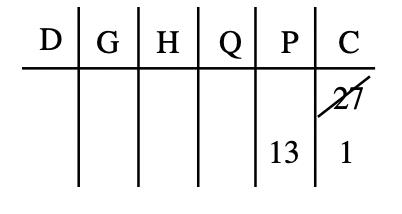
3. To consolidate the pints into quarts, we divide the number of pints (13) by 2 (the base) which gives 6 quarts (the quotient) and 1 pint left over (the remainder). Cross off the 13 and show new quotient and remainder. See below.
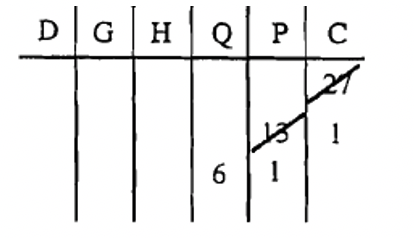
4. To consolidate the quarts into half-gallons, we divide the number of pints (6) by 2 (the base) which gives 3 half-gallons (the quotient) and zero quarts left over. See below for how to keep track.
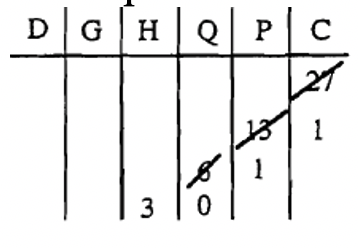
5. To consolidate the half-gallons into gallons, we divide the number of half-gallons (3) by 2 (the base), giving us 1 gallon (the quotient) and 1 half-gallon left over. Keep track as shown below
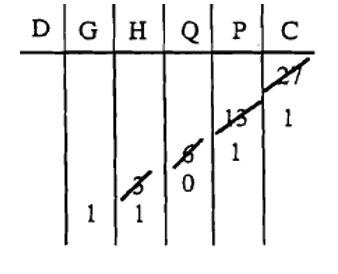
At this point, we can't consolidate any further. As you do each division, the remainder must always be less than what you are dividing by, which is the base. Once you get a quotient that is also smaller than the base, you are done converting the number to the desired base. In this example, we were converting to base two. Therefore, we simply read the chart above to get the answer of \(11011_{\text{two}}\).
So, \(27 = 11011_{\text{two}}\).
The above algorithm (or method) works to convert any Base Ten numeral to any other base. Below are steps:
1. Start by putting the number to convert in the unit's place. Divide the number by the base. The new quotient goes in the next place value to the left and the remainder goes in the unit's place.
2. Divide the quotient you just got by the base. The new quotient goes in the next place value to the left and the remainder goes in the old quotient's place.
3. Repeat step 2 until the quotient is less than the base. Now write the numeral in the base you were converting to. Remember to write out the base as a number name ("two","three", etc.) to the right of the number!!!!! Lastly, but most importantly, CHECK YOUR Answer by converting back to a Base Ten numeral!
If you forgot how to use the calculator to easily find the quotient and remainder when doing division problems, look back at page 18 of Exercise Set 2 and practice exercise 8 again. Record each quotient and remainder in a careful, organized manner as you work through the problem. Then, at the end of the computation, it is easy to write the numeral in the new base. Notice how well this works in the next few examples.
Example 1
Convert 82 to Base Six.
The chart where I keep track is below.
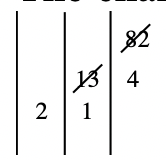
My computations were:
\(82 \div 6 = 13\) rem. \(\underline{4}\)
\(13 \div 6 = 2\) rem. \(\underline{1}\)
Since the last quotient, \(\underline{2}\), was less than the base, 6, this signaled the end of the problem. So 82 as a numeral in Base Six is recorded as \(\mathbf{214}_{\mathbf{six}}\). Check to see if \(214_{\text{six}}\) really is 82.
Exercise 2
Convert 477 to Base Five.
The chart where I keep track of the quotients/remainders is shown below.

My computations were:
\(477 \div 5 = 95\) rem. \(\underline{2}\)
\(95 \div 5 = 19\) rem. \(\underline{0}\)
\(19 \div 5 = 3\) rem. \(\underline{4}\)
So 477 as a numeral in Base Five is recorded as \(\mathbf{3402}_{\mathbf{five}}\). Check to see if \(3402_{\text{five}}\) really is 477.
Exercise 3
Convert 477 to Base Twelve.
The chart where I keep track of the quotients/remainders is shown below.
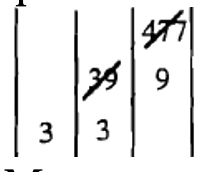
My computations were:
\(477 \div 12 = 39\) rem. \(\underline{9}\)
\(39 \div 12 = 3\) rem. \(\underline{3}\)
So 477 as a numeral in Base Twelve is recorded as \(\mathbf{339}_{\mathbf{twelve}}\). Check to see if \(339_{\text{twelve}}\) really is 477.
Example 4
Convert 477 to Base Three.
The chart where I keep track of the quotients/remainders is shown below.
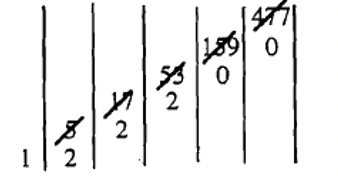
My computations were:
\(477 \div 3 = 159\) rem. \(\underline{0}\)
\(159 \div 3 = 53\) rem. \(\underline{0}\)
\(53 \div 3 = 17\) rem. \(\underline{2}\)
\(17 \div 3 = 5\) rem. \(\underline{2}\)
\(5 \div 3 = 1\) rem. \(\underline{2}\)
So 477 as a numeral in Base Three is recorded as \(\mathbf{122200}_{\mathbf{three}}\). Check to see if \(122200_{\text{three}}\) really is 477.
Study the previous examples carefully before working through the next exercise. The key is to be organized in your work writing down each step in the process.
Exercise 8
Convert each Base Ten numeral to the specified base and put a box around your answer. Then, check your answer by converting the answer back to Base Ten.
| a. 200 to Base Four | b. 450 to Base Seven |
| c. 89 to Base Two | d. 264 to Base Three |
| e. 320 to Base Thirteen |
The algorithm we have been employing should make sense given the way we converted to other bases from Base Ten using the Base Blocks. This method is fairly straightforward and you do not need to know the actual place values as you fill in the place holders. You also do not know how many digits the numeral will have until you have finished the problem. There is another method of converting which we will now study. For this second method, we determine and write out the actual place values and figure out the number of digits the numeral will have as the first step of the problem.
\[ \begin{aligned} \frac{\mathbf{2}}{36} \frac{}{6} \frac{}{1} \\ \frac{\mathbf{2}}{36} \frac{\mathbf{1}}{6} \frac{}{1} \\ \frac{\mathbf{2}}{36} \frac{\mathbf{1}}{6} \frac{\mathbf{4}}{1} \end{aligned} \nonumber \]
We will now convert 82 to Base Six using a new algorithm. We will look at the process of converting very differently. First, we consider the place values in a Base Six numeral. Since we only need to go up to 82, we do not need to show a place value greater than 82. Our first step is to write a place value chart for Base Six with the place values shown under blank spaces where we will fill in the digits for the Base Six numeral. This is shown to the right. Notice this will be a three digit numeral. Starting from the left, the first digit (in the 36's place) will indicate how many 36's are in 82. This is the division problem: \(82 \div 36 = 2\), rem. 10. Thus, 2 will be the first digit and we have 2 __ __ six for our numeral thus far. We now have to take the remainder of 10 and do the same thing for the next place value. To determine how many 6's are in 10, we do this division problem: \(10 \div 6 = 1\), rem. 4. This gives a 1 for the next digit in the numeral, so we have 2 1 __six and we are almost done. When you are down to the units place, the remainder goes in the units place. So 82 converts to \(214_{\text{six}}\) which is the same answer we got when we computed it using the first algorithm. On the left, you can see the three steps taken as you fill in the chart on your way to writing the final answer in Base Six. Remember to check the answer!
\[ \begin{aligned} \frac{\mathbf{3}}{125} \frac{}{25} \frac{}{5} \frac{}{1} \\ \frac{\mathbf{3}}{125} \frac{\mathbf{4}}{25} \frac{}{5} \frac{}{1} \\ \frac{\mathbf{3}}{125} \frac{\mathbf{4}}{25} \frac{\mathbf{0}}{5} \frac{}{1} \\ \frac{\mathbf{3}}{125} \frac{\mathbf{4}}{25} \frac{\mathbf{0}}{5} \frac{\mathbf{2}}{1} \end{aligned} \nonumber \]
Let's convert 477 to Base Five using this algorithm. First determine the place values for Base Five, noting you do not fill in place values higher than 477. This is shown on the top line to the right. We now know there are four digits in this Base Five numeral. Step 1 is to determine how many 125's are in 477 which is the division problem: 477 125 = 3, rem. 102. The sequence of steps for filling in the numeral is shown to the right. Notice the 3 in the first place value. Next, we must determine how many 25's are in 102 (the remainder). I hope you don't need a calculator for this one. There are 4, with a remainder of 2. So, 4 gets filled into the 25's place. We are left with a remainder of 2 and since there are no 5's in 2,a 0 is put in that place value. Next is the units place so the 2 gets deposited there. Hence, the answer is \(3402_{\text{five}}\) which is exactly what we arrived at when using the first algorithm. Make sure you remember to check the answer!
\[ \frac{}{128} \frac{}{64} \frac{}{32} \frac{}{16} \frac{}{8} \frac{}{4} \frac{}{2} \frac{}{1} \nonumber \]
Let's convert 77 to a Base Two numeral using this algorithm. First, look at some Base Two place values shown above. The only digits in Base Two are 1's and 0's. You don't really have to do any division problems. The first digit will always be a 1 and it will be in the highest place value that can be subtracted from the number we are converting. 77 converts to a seven digit numeral with a 1 in the 64's place since 64 is the highest place value that can be subtracted from 77. Place a 1 in that place value and subtract (77 - 64 = 13). Take the new number, 13, and find the next highest place value from which 13 can be subtracted, putting a 0 in any place value greater than 13. This forces a 0 in the next two place value spots –32 and 16. Put a 1 in the 8's place since it is the highest place value that can be subtracted from 13. After subtracting 8 from 13, we have 5. Put a 1 in the 4's place since 4 can be subtracted from 5, leaving a 1. This forces a 0 in the place value for 2 and the remainder of 1 goes in the units place.
To the left is a way to keep track of each subtraction made. Simply put a 1 in each place value subtracted (note check marks) and a zero for all other place values. Hence, the answer is \(\mathbf{1001101}_{\mathbf{two}}\). This is easily checked: 64 + 8 + 4 + 1 = 77.
Exercise 9
Convert the Base Ten numeral 155 to the base specified using the second algorithm presented.
| a. Base Three | b. Base Twelve |
| c. Base Two | d. Base Five |
Exercise 10
Use any algorithm you prefer to convert 13595 to the base specified. SHOW WORK!
| a. Base Eleven | b. Base Thirteen |
Exercise 11
Convert 838 to the base specified.
| a. Base Twelve | b. Base Eight |
| c. Base Seven | d. Base Nine |
Both methods shown for converting a Base Ten numeral to a different base work well. But the approaches are very different. It's best if you can both understand and do it either way. Eventually, you'll settle on doing it one way over the other. For years, I only did it using the second algorithm because that was the only way I knew how to do it. Now, I find the first method more interesting. Whichever way you choose to convert, it's very important for you to check your work by converting back to Base Ten.
Exercise 12
Discuss the differences and advantages of each algorithm used to convert a Base Ten numeral to a different base. Which method do you prefer and why?
The last topic we will explore is how to count in bases other than Base Ten. In other words, how can we write down a sequence of counting numerals in a given base without converting each numeral from Base Ten one at a time? Also, you will learn how to take a numeral in a given base and, without any converting, state both the previous and next numeral in that same base.
Begin by studying patterns in the counting numerals in Base Ten. We'll start with zero although it really isn't a counting number. Read across one row at a time.
| 0 | 1 | 2 | 3 | 4 | 5 | 6 | 7 | 8 | 9 |
| 10 | 11 | 12 | 13 | 14 | 15 | 16 | 17 | 18 | 19 |
| 20 | 21 | 22 | 23 | 24 | 25 | 26 | 27 | 28 | 29 |
and so on for a while until we get to...
| 80 | 81 | 82 | 83 | 84 | 85 | 86 | 87 | 88 | 89 |
| 90 | 91 | 92 | 93 | 94 | 95 | 96 | 97 | 98 | 99 |
| 100 | 101 | 102 | 103 | 104 | 105 | 106 | 107 | 108 | 109 |
| 110 | 111 | 112 | 113 | 114 | 115 | 116 | 117 | 118 | 119 |
and again this goes on for a while until we get to...
| 980 | 981 | 982 | 983 | 984 | 985 | 986 | 987 | 988 | 989 |
| 990 | 991 | 992 | 993 | 994 | 995 | 996 | 997 | 998 | 999 |
| 1000 | 1001 | 1002 | 1003 | 1004 | 1005 | 1006 | 1007 | 1008 | 1009 |
and you know how this goes on and on and on, right?
Here are some things to pay attention to:
- The last digit always changes from one numeral to the next
- As you look across each row, only the last digit changes from one numeral to the next
- Notice how many numerals are written in a row before more than just the last digit changes from one numeral to the next
- When more than the last digit changes, note the last digit of the previous numeral and the last digit of the new numeral
- Notice what it takes to change from a one digit numeral to a two digit numeral, from a two digit numeral to a three digit numeral, from a three digit numeral to a four digit numeral, etc
- Notice the pattern of the first two, three or four digit numeral, etc
Exercise 13
In Base Ten, how many consecutive numerals can you write in a row before having to change more than one digit? ____
Exercise 14
In Base Ten, what is true of the numeral if more than the last digit changes when you write the next numeral? _____
Exercise 15
In Base Ten, what is the largest eight digit numeral? ____
Exercise 16
In Base Ten, what is the smallest ten digit numeral? ____
Study this counting chart in Base Three. It starts with zero and counts to 95 which is \(10112_{\text{three}}\). Read across each row and then down the page. Try to recognize patterns similar to ones found in Base Ten. Then, answer the questions on the right side of the page.
| \(0_{\text{three}}\) | \(1_{\text{three}}\) | \(2_{\text{three}}\) |
| \(10_{\text{three}}\) | \(11_{\text{three}}\) | \(12_{\text{three}}\) |
| \(20_{\text{three}}\) | \(21_{\text{three}}\) | \(22_{\text{three}}\) |
| \(100_{\text{three}}\) | \(101_{\text{three}}\) | \(102_{\text{three}}\) |
| \(110_{\text{three}}\) | \(111_{\text{three}}\) | \(112_{\text{three}}\) |
| \(120_{\text{three}}\) | \(121_{\text{three}}\) | \(122_{\text{three}}\) |
| \(200_{\text{three}}\) | \(201_{\text{three}}\) | \(202_{\text{three}}\) |
| \(210_{\text{three}}\) | \(211_{\text{three}}\) | \(212_{\text{three}}\) |
| \(220_{\text{three}}\) | \(221_{\text{three}}\) | \(222_{\text{three}}\) |
| \(1000_{\text{three}}\) | \(1001_{\text{three}}\) | \(1002_{\text{three}}\) |
| \(1010_{\text{three}}\) | \(1011_{\text{three}}\) | \(1012_{\text{three}}\) |
| \(1020_{\text{three}}\) | \(1021_{\text{three}}\) | \(1022_{\text{three}}\) |
| \(1100_{\text{three}}\) | \(1101_{\text{three}}\) | \(1102_{\text{three}}\) |
| \(1110_{\text{three}}\) | \(1111_{\text{three}}\) | \(1112_{\text{three}}\) |
| \(1120_{\text{three}}\) | \(1121_{\text{three}}\) | \(1121_{\text{three}}\) |
| \(1200_{\text{three}}\) | \(1201_{\text{three}}\) | \(1202_{\text{three}}\) |
| \(1210_{\text{three}}\) | \(1211_{\text{three}}\) | \(1212_{\text{three}}\) |
| \(1220_{\text{three}}\) | \(1221_{\text{three}}\) | \(1222_{\text{three}}\) |
| \(2000_{\text{three}}\) | \(2001_{\text{three}}\) | \(2002_{\text{three}}\) |
| \(2010_{\text{three}}\) | \(2011_{\text{three}}\) | \(2012_{\text{three}}\) |
| \(2020_{\text{three}}\) | \(2021_{\text{three}}\) | \(2022_{\text{three}}\) |
| \(2100_{\text{three}}\) | \(2101_{\text{three}}\) | \(2102_{\text{three}}\) |
| \(2110_{\text{three}}\) | \(2111_{\text{three}}\) | \(2112_{\text{three}}\) |
| \(2120_{\text{three}}\) | \(2121_{\text{three}}\) | \(2122_{\text{three}}\) |
| \(2200_{\text{three}}\) | \(2201_{\text{three}}\) | \(2202_{\text{three}}\) |
| \(2210_{\text{three}}\) | \(2211_{\text{three}}\) | \(2212_{\text{three}}\) |
| \(2220_{\text{three}}\) | \(2221_{\text{three}}\) | \(2222_{\text{three}}\) |
| \(10000_{\text{three}}\) | \(10001_{\text{three}}\) | \(10002_{\text{three}}\) |
| \(10010_{\text{three}}\) | \(10011_{\text{three}}\) | \(10012_{\text{three}}\) |
| \(10020_{\text{three}}\) | \(10021_{\text{three}}\) | \(10022_{\text{three}}\) |
| \(10100_{\text{three}}\) | \(10101_{\text{three}}\) | \(10102_{\text{three}}\) |
| \(10110_{\text{three}}\) | \(10111_{\text{three}}\) | \(10112_{\text{three}}\) |
Exercise 17
In Base Three, how many consecutive numerals can you write in a row before having to change more than one digit?
Exercise 18
In Base Three, what is true of the numeral if more than the last digit changes when you write the next numeral?
Exercise 19
In Base Three, what is the smallest seven digit numeral?
Exercise 20
In Base Three, what is the largest seven digit numeral?
Exercise 21
For each Base Three numeral, write the next consecutive numeral:
| a. \(1 \ 202 \ 010_{\text{three}}\) : |
| b. \(2 \ 220 \ 011_{\text{three}}\) : |
| c. \(1 \ 010 \ 102_{\text{three}}\) : |
| d. \(2 \ 100 \ 212_{\text{three}}\) : |
| e. \(2 \ 120 \ 222_{\text{three}}\) : |
Exercise 22
For each Base Three numeral, write the numeral that precedes it:
| a. \(1 \ 200 \ 102_{\text{three }}\) |
| b. \(1 \ 202 \ 221_{\text{three}}\) |
| c. \(2 \ 110 \ 020_{\text{three}}\) |
| d. \(2 \ 110 \ 100_{\text{three}}\) |
Exercise 23
What is wrong with the numeral, \(1 \ 022 \ 301_{\text{three}}\)
Exercise 24
Starting with zero, count to 23 in Base Four by filling in the missing numerals.. Count across each row as was done in Base Ten and Base Three.
| \(0_{\text{four}}\) | \(2_{\text{four}}\) | \(3_{\text{four}}\) | |
| \(11_{\text{four}}\) | |||
| \(20_{\text{four}}\) | \(23_{\text{four}}\) | ||
| \(112_{\text{four}}\) |
Check by picking a random numeral in the list. Take \(112_{\text{four}}\) from the above list. Since you started counting from zero, that numeral should be the same as \(22_{\text{ten}}\), which is what \(112_{\text{four}}\) converts to in Base Ten. Always check the last numeral too. In this case, the last numeral should convert to 23. Perhaps you are asked to count from 121 to 135 in Base Five. The first step would be to convert 121 to a Base Five numeral, which is \(441_{\text{five}}\). Then, start counting by writing each successive numeral. The fifteen numerals are listed:
\(441_{\text{five}}, 442_{\text{five}}, 443_{\text{five}}, 444_{\text{five}}, 1000_{\text{five}}, 1001_{\text{five}}, 1002_{\text{five}}, 1003_{\text{five}}, 1004_{\text{five}}, 1010_{\text{five}}, 1011_{\text{five}}, 1012_{\text{five}}, 1013_{\text{five}}, 1014_{\text{five}}, 1020_{\text{five}}\)
To check, take a random numeral in the middle, \(1003_{\text{five}}\), convert it and find it is 128. In the sequence, it should equal 128. Then, I check the last numeral \(1020_{\text{five}}\) and make sure it converts to 135, which it does. This indicates that probably the rest are also correct.
Exercise 25
Count from 1 to 20 in Base Two
Exercise 26
Count from 61 to 68 in Base Eight
Exercise 27
For each numeral, write the numeral that precedes it and also, its successor. Try to do it without converting! Afterwards, you can convert to check it
| a. ____, \(3027_{\text{eight}}\), ____ | ||
| b. ____, \(1240_{\text{five}}\), ____ | ||
| c. ____, \(101100_{\text{two}}\), ____ |
Exercise 28
For each base given, assume you had the designated number of blocks, flats, longs and/or units. State how to write the numeral in that base and also in base ten.
a. Base Three: 4 blocks, 5 flats, 1 long and 4 units
b. Base Eight: 19 flats, 7 longs and 13 units
c. Base Five: 1 block, 13 longs and 15 units


